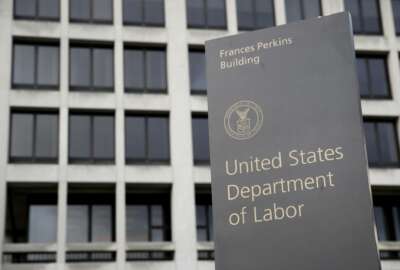Hubbard Radio Washington DC, LLC. All rights reserved. This website is not intended for users located within the European Economic Area.
Federal Housing Finance Agency to kickstart negotiations for first-ever union contract
Pay equity, employee engagement and a clear grievance procedure are top of mind for a nearly brand-new bargaining unit at the Federal Housing Finance Agency.
With labor and management leaders preparing to sit down at the bargaining table, hundreds of employees at the Federal Housing Finance Agency may soon see changes in their workplace.
Pay equity, employee engagement and the creation of a clear grievance procedure are top of mind for Nathan Watkins, president of the nearly brand-new bargaining unit under the National Treasury Employees Union.
“It was almost exactly two years ago that a small group of employees, including myself, reached out to a couple of national unions trying to form a chapter at FHFA,” Watkins said in an interview. “We wanted, first and foremost, to give employees a voice.”
The organization campaign for FHFA, a small financial regulatory agency with a staff of a little over 700 employees, culminated in an overwhelmingly majority vote to unionize in August 2023. FHFA employees voted 254-24, or 91%, in favor of the union’s establishment. Currently, the bargaining unit represents about 500 employees.
“It was a wonderfully affirming, encouraging, uplifting result — but then there was so much work to do,” Watkins said. “All of a sudden, we’re bargaining the impact and implementation of certain policy changes and merit increases for the year.”
The next steps for the new NTEU bargaining unit are to sit down with FHFA management to negotiate and eventually sign off on the first-ever collective bargaining agreement for the agency. The upcoming contract will cover many areas that directly impact the workforce, including pay, benefits, work hours and other employment conditions. It is expected to be finalized sometime this year.
It’s a lot of work on the plate of what Watkins said is a “very small shop” of bargaining unit leaders.
“I’ve forgotten the rhythm of ‘9-to-5,’” he said. “It might be a bit of a pipe dream, but getting a good night’s sleep every night for a week would really show that we’ve pulled it off.”
The creation of a bargaining unit has been a long time coming. Over the last few years, FHFA has experienced a decline in employee engagement, according to the results of the Federal Employee Viewpoint Survey (FEVS) and the Partnership for Public Service’s Best Places to Work rankings. Satisfaction with pay, similar to federal employees at many other agencies, has also been declining for several years.
“Despite there being such a high morale drop, we saw a rapid climb to the top of response rates by agency,” Watkins said. “We still don’t believe that we’re being heard by the agency.”

Bob Stanton, FHFA’s branch chief of performance management and total rewards, said having FEVS results on hand — including the spike in response rate — is crucial to making improvements going forward.
“We’re looking forward to the upcoming FEVS, to be honest with you,” Stanton said in an interview. “We want to continue to learn from our employees, and we want to continue to learn from the union and have that collaborative relationship with them.”
There are other ways FHFA has been trying to gather feedback from employees. In addition to FEVS, the agency has “engagement ambassadors” who meet regularly to discuss ideas to better engage employees. Staff members can also use an online platform called “idea scale” to bring their suggestions for improving engagement up to the leadership level, said Debra Chew, FHFA’s director of the Office of Equal Opportunity and Fairness.
“Through that process, we were really intentional in making sure that we were listening to the workforce and receiving their input,” Chew said in an interview.
In response to feedback, FHFA has offered “wellness” time off, which includes three hours of leave per pay period, and one full workday a year. Additionally, Chew said the agency offers full-time telework during the month of August, which can be difficult for employees who have kids at home returning back to school that month.
But in cases where there are further concerns from employees, Watkins said establishing an administrative grievance process is necessary as part of the collective bargaining agreement. It’s a way for employees to formally file concerns with management to then be addressed and resolved.
“We also want to really fill the void that is there right now, where employees can receive information from the agency about policies or resources that are available,” Watkins said. “It will give employees a voice so that their concerns, even if they’re not formal grievances, can be heard and acknowledged by the agency. That exchange of information to and from employees is one of our top priorities. I hope that the agency will hear us and acknowledge our appetite to speak up, to be heard and to work with us.”
Chew and Stanton expressed support for the establishment of an official grievance process, saying that it’s a benefit to the agency as much as it is to employees.
“We need vehicles and mechanisms to hear employee concerns and have those concerns help inform how leadership responds to employees, and help inform our policy development process,” Chew said.
One of the perhaps most notable collective bargaining topics Watkins will focus on in negotiations is establishing better pay equity at the agency. FHFA is a non-appropriated agency, which means the FHFA director has discretion in setting pay rates for employees, rather than deferring to the General Schedule. The agency uses a “pay for performance” system, in which employees receive annual salary increases based on their individual performance, and are eligible for performance-based annual bonuses.
There are also legal requirements for FHFA to keep on track with the pay rates of other federal financial regulators, including the Securities and Exchange Commission, the Consumer Financial Protection Bureau and the Federal Deposit Insurance Corporation.
Despite that, Watkins said FHFA pay has been lagging for some employees, as salary history holds a lot of weight.
“A lot, if not the majority, of employees who join FHFA come from the private sector or other financial regulators,” Watkins said. “Their salary upon hire generally sets their salary trajectory at the agency.”
FHFA pay satisfaction over time

The Biden administration has picked up on concerns around salary history as well. The Office of Personnel Management just finalized a rule barring agencies from considering salary history in the hiring process, which OPM Director Kiran Ahuja said can exacerbate preexisting inequalities, and disproportionally impact women and workers of color.
“Salary history is not necessarily a good indicator of worker value, experience and expertise, and it also may contain or exacerbate biases,” OPM said in the Jan. 29 final rule. “Pay setting based on salary history may be inequitable, can perpetuate biases from job to job, and may contribute to a pay gap between the earnings of men and women.”
By this October, agencies will no longer be able to set new or returning federal employees’ pay based on their private sector wages. Still, federal employees who have already been working at an agency, such as FHFA, may not see many changes as a result, since the final rule from OPM generally applies only to new or returning federal hires.
“Employees who may have joined FHFA earlier in their careers, being very competent and successful at FHFA, nonetheless make less than their peers at the same level without any chance of increasing their salary,” Watkins said.
Stanton and Chew said the agency is conducting a compensation study to better understand where there may be existing pay gaps — and how to correct them.
“It’s our first time being in the union environment,” Stanton said. “Our collaboration really began with listening to the concerns of the union and working with them. Now we are focusing on the future, and solutions that are beneficial to the bargaining unit and workforce. We all share the same goal — we want FHFA to be the best place to work.”
Watkins said “heavy-handed” management practices as well as a culture of fear and retaliation that he and his colleagues experienced was what first led to the decision to embark on creating a union at FHFA. Still, Watkins added that he’s optimistic about negotiations for the first-ever collective bargaining agreement. He said he’s hoping establishing clear policies on pay, benefits and a grievance procedure will reverse the current downward trend in employee engagement.
“I’m completely confident that management and senior leaders, when we get to the table with them, will recognize that we are all humans and colleagues working toward the same goal,” Watkins said. “I hope that by the end of contract negotiations — as difficult as the process will be — we’ll really have that mutual benefit that unions provide for federal agencies. I’m hopeful that we’ll work hand in hand with the agency in the future.”
Copyright © 2024 Federal News Network. All rights reserved. This website is not intended for users located within the European Economic Area.
Drew Friedman
Drew Friedman is a workforce, pay and benefits reporter for Federal News Network.
Follow @dfriedmanWFED





